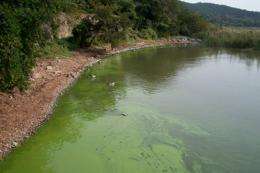Runoff key to reducing certain toxic aquatic blooms

(PhysOrg.com) -- Many scientists believe that an unfortunate perfect storm of climate change and nutrient runoff will synergistically increase toxic cyanobacterial blooms globally in coming years.
A synthesis article co-authored by a Cornell researcher in the Perspectives section of the Oct. 6 issue of the journal Science argues that local efforts to control such nutrient runoff as phosphorus and nitrogen from farms, lawns and parking lots into streams, lakes and rivers -- and ultimately the oceans -- could stave off cyanobacterial blooms around the world, despite a warming climate.
Cyanobacterial blooms, which occur in fresh and marine waters, are bad news. They negatively affect water quality; can be toxic to animals, including humans, that swim in or drink contaminated water; and can lead to substantial economic losses due to water treatment costs, declining property values, and lost tourism and recreational revenues.
Cyanobacterial blooms are part of a mix of toxic phytoplankton that create dead zones in the Gulf of Mexico each summer, for example.
The researchers analyzed prior experiments, historical data and modeling studies, and found that warming waters are favorable to cyanobacterial blooms only in the presence of high nutrient concentrations. Studies show that when lakes receive lower nutrient inputs, cyanobacterial blooms can be kept in check in spite of warming water, according to the researchers' article.
"Nutrients are consistently the more important driver of blooms in lakes," as compared to climate change, said Cayelan Carey, a graduate student in field of ecology and evolutionary biology and a co-author of the paper with Justin Brookes, associate professor of ecology at the University of Adelaide, Australia.
"This is good news, because decreasing nutrient loading, which operates on a local and decadal scale, is a much more feasible option for controlling cyanobacterial than decreasing global temperatures, which requires international cooperation and century-long time scales," she added.
As a result, the researchers argue that increasing cyanobacterial blooms are not inevitable if local communities work together to minimize nutrient runoff.
For example, people often overuse fertilizers and can reduce the amount they use on lawns, gardens and farm fields, Carey said. For lawns that reach the edge of a stream, lake or pond, planting a buffer of wetland plants will absorb nutrients before they run off into the water. Also, such impervious surfaces as roads and parking lots lead to greater runoff; increasing vegetation and removing impervious surfaces allow water to soak into the ground and slow such runoff, Carey said.
Provided by Cornell University

















